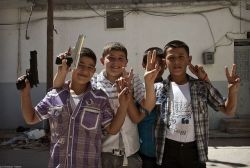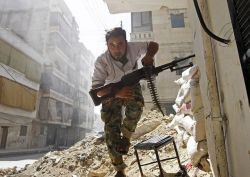Exercise: Look up examples of news photographs of emergencies. Are the pictures objective? Can pictures ever be objective? Write a list of the arguments for and against.
Approach: From 911 and the London Bombings to the Japanese Tsunami and landslides in Nepal there is a wealth of documentary images of emergencies on the web. I wanted to include some images as part of the blog and after looking through flickr I found the two above. I chose to include these two here because in some ways I thought they highlighted the contrast, both looking direct to camera but one apparently posed and one more of an action shot. As a viewer you might be forgiven for assuming one is an ‘objective’ journalist shot taken at a crucial point in time. Whereas the other is arranged, and a more familiar group portrait type shot, a more leisurely image where it is probable that the photographer arranged it and chose the moment to press the shutter. There are of course alternative readings, there is no way of knowing that the Free Syrian Army Fighter is who the caption says he is and where he is, we are being asked to put our trust in the photographer. This issue of truth and objectivity was highlighted in the recent coverage of the staged Syrian ‘hero boy’ Youtube video.
Equally, the group shot of the boys could have been something they staged and asked the photographer to take for them, or their parents asked to have recorded. Looking at it from my uniformed perspective I have no way of knowing if the guns are toys, again it is only the caption that for me delivers that information.
Considering arguments that might be made for or against objectivity in documentary photography I would suggest the following:
For
• An outsider view brings and open perspective
• Shot might have been taken quickly so no time to pose or fully see the entire frame
• Photographer may be in fear of own safety and therefore work very quickly
• The outsider may not fully understand the context and therefore is objective by virtue of their naivety
Against
• Images are always from a human viewpoint therefore they bring some background
• Shooting to a brief
• Technology can make things look ‘natural’
• Technology makes manipulation easier
• Similar frames and rules to follow – still composing in the frame
• Images are later selected or cropped so we don’t know what has been included or left out or who had the final say
Drawing on my experience as a researcher I question the ability of anyone to be completely objective, I have always tended to work with the notion of ‘critical subjectivity.’ It is based on the view that meaning is not static; it is continually created and recreated. This means that there was no single ‘truth’ to be found in the field.
The polar perspectives of objectivity and subjectivity are thereby replaced by ‘critical subjectivity’, meaning that “we do not suppress our primary subjective experience, that we accept our knowing is from a perspective; it also means that we are aware of that perspective, and of its bias, and we articulate it in our communications.”(Reason & Rowan, 1981)
Reason (1994) argues that critical subjectivity involves a self-reflexive attention to the ground on which one is standing and thus it may be close to what Bateson (1972b) describes as Learning III (see table 5). This notion of critical subjectivity means that there will be many versions of “reality” to which people may hold. It also means that the method is open to all the ways in which human beings fool themselves and each other in their perceptions of the world.
References and citations
Reason, P. (1994). Three Approaches to Participative Inquiry. In N. Denzin, K & Y. Lincoln, S (Eds.), Handbook of Qualitative Research (pp. 324-339). Thousand Oaks: Sage.
Reason, P., & Rowan, J. (Eds.). (1981). Human Inquiry: A Sourcebook of new Paradigm Research. Chichester: Wiley.
Images
Syria Crisis © 2012 Goran Tomasevic/Reuters available under licence: Attribution-NoDerivs 2.0 Generic flickr
A Free Syrian Army fighter takes cover during clashes with Syrian Army in the Salaheddine neighbourhood of central Aleppo
Azaz, Syria © 2012 Christiaan Triebert available under licence: Attribution 2.0 Generic flickr
Four young Syrian boys with toy guns are posing in front of my camera during my visit to Azaz, Syria. Most people I met were giving the peace sign. This little city was taken by the Free Syrian Army in the summer of 2012 during the Battle of Azaz.























